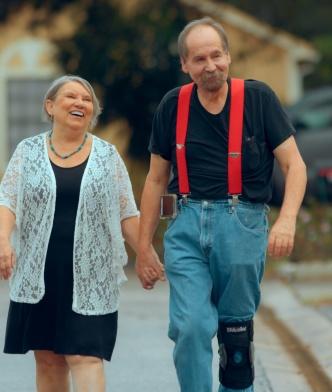Foot and Ankle Specialist, Fort Myers
12800 University Drive, Suite 600Fort Myers, FL 33907
Rating Overview
- The Fee Is Free Unless You Win®.
- America's Largest Injury Law Firm™
- Protecting Families Since 1988
- 20 Billion+ Won
- 1,000+ Lawyers Nationwide
Free Case Evaluation

The attorneys featured above are licensed in Florida. For a full list of attorneys in your state please visit our attorney page.
Foot and Ankle Specialist, Fort Myers
While foot or ankle trauma sustained in a car accident isn't among the most serious injuries, this kind of damage can be extremely painful and disruptive to your life. Injuries to the lower limbs are frequent, particularly in certain types of collisions like rear-end, side-impact, and head-on accidents. Feet, toes, and ankles absorb a disproportionate amount of force when the legs twist and distort from the jolt of the impact.
While these injuries are painful, they can also lead to permanent issues with mobility without proper treatment. Sometimes, the damage is so severe that individuals have to live with lifetime limitations, even with expert care. Suppose you or a loved one has suffered a debilitating lower limb injury. In that case, you may find some relief through a foot and ankle specialist. Fort Myers has a decent number of these trained professionals, but if you want a solid referral to a trusted expert who has treated car accident victims, contact Morgan and Morgan.
Since these conditions can be costly to treat, you might also consider your options to get the other party to pay for your medical expenses. Suppose the other driver was primarily responsible for the accident, and your injuries are significant. In that case, a car accident lawyer may be able to demonstrate why you should be entitled to bring a liability claim or lawsuit against the at-fault party's insurance company, regardless of Florida's no-fault insurance rules.
Get answers to commonly asked questions about our legal services and learn how we may assist you with your case.
Morgan & Morgan
Why Are Feet and Ankles Prone to Injury in a Car Accident?
Feet and ankles are hyper-prone to injury in car accidents like T-bones and head-on collisions because the foot space within a vehicle is often crushed. We instinctively put pressure on our feet to brace ourselves from the impact, which causes tremendous energy to be dispersed throughout the ankles and feet. While this happens to both drivers and passengers, drivers are more likely to sustain injury to their right foot because they push down forcefully on the brakes in an attempt to avoid the collision.
The ankle is an intrinsic bodily part that allows us to stand erect and walk. It comprises three core bones called the tibiae and fibulae of the lower legs and the talus of the feet, although smaller bones like the lateral, medial, and posterior malleolus or the mortise can be fractured in a car accident. The ankle is connected together by a range of ligaments, all of which can be strained or sprained during a collision.
The foot is the most complex structure of the body since it's made up of over 100 moveable parts, including bones, tendons, muscles, ligaments, and nerves. The foot is crucial to our ability to stand, walk, run, jump, climb, and maintain our balance.
Any injury to the foot or ankle can tremendously impact the quality of life an individual will have in the future, making it a priority for those who have suffered such an injury to find a qualified foot and ankle specialist. Fort Myers car accident lawyers at Morgan and Morgan are ready to point you in the right direction for treatment and for compensation.
What Are Common Foot and Ankle Injuries From Car Accidents?
Having full and painless use of our extremities is crucial to leading a gratifying life. Many people only realize how vital these body parts are after suffering a debilitating injury. These injuries can be temporary, subject to time and healing, yet others lead to permanent damage. Here are some common foot and ankle injuries suffered in car accidents:
Ankle Bone Fractures
- Fibula only fracture
- Bimalleolar ankle fracture
- Trimalleolar fractures
- Tibia only fracture (pilon fracture)
- Maisonneuve fracture
Ankle bone fractures may require x-rays, and MRI scans to diagnose and could involve surgical treatment to reposition bones, implant surgical pins, remove bone fragments, and repair damaged surrounding ligaments.
How to Tell if Your Ankle Is Sprained or Broken?
A fracture is a medical term for a broken bone. A sprain is when the ligaments that support the bone structure are stretched or torn. Most of us have no medical training, so it may be hard to distinguish a broken bone from a painful sprain. However, here are some guidelines that may indicate you need treatment for a broken ankle bone:
- Deformity
- Bruising
- Swelling
- Immediate throbbing pain
- Tenderness
- Trouble or pain when walking or putting weight on it
Unfortunately, the symptoms of a sprained ankle have some similarities, with a few exceptions:
- Pain when bearing weight on the affected foot
- Tenderness to the touch
- Swelling
- Bruising
- Restricted range of motion
- Instability in the ankle
- A popping sound or sensation at the time of the injury
Foot injuries-fractures
- Heel bone fracture
- Metatarsal fracture
- 5th metatarsal fracture
- Pilon fracture
- Lisfranc fracture
- Snowboarder's fracture
- Stress fracture
Frequently treating a fractured bone in the foot requires surgery to realign the bones, wearing a splint, cast, or boot, and a program of physiotherapy.
Foot injuries-sprains
Grade I (tiny tears in the ligaments of the foot)
Grade II (large tears in the ligaments of the foot
Grade III (ligaments have become totally detached or displaced from the bone)Sprained foot symptoms
- Pain and tenderness in the arch of the foot, which can be felt on the top, bottom, or sides of the foot
- Bruising and swelling on the foot
- Pain or inability to walk or put weight on the foot
Surprisingly, a severe sprain in the foot can take as long as six to eight months to heal fully and may require surgery to reduce the bone.
These are just some guidelines, but it's never advisable to self-diagnose from articles on the Internet. We highly recommend that if you're feeling any foot or ankle pain after a car accident, you should seek out appropriate medical care to get an accurate diagnosis and treatment.
Why Should I See a Doctor Following a Car Accident?
The benefits of seeing a doctor following a car accident are two-fold. The most important is that serious injuries aren't left untreated. Some foot and ankle injuries can cause severe issues down the road. For example, sprains can cause the ankle or foot to become unstable, leading to chronic pain, instability, swelling, and, finally, arthritis. Likewise, if left untreated, it can increase your chances of a future sprain.
Untreated fractures can cause permanent damage to nerves that leads to difficulty controlling movement, as well as permanent tingling sensations, permanent deformity, and fracture blisters where the skin adheres tightly to the malformed bone. Since the ankles and feet are the foundation of the body, seeking medical care following an accident is of paramount importance. Complications can last a lifetime, especially if left undiagnosed.
The second most critical reason to get medical care following an accident is to document injuries. Medical documentation is crucial if you want to get compensated for your injuries. Medical records allow both sides to evaluate the extent of the injuries and estimate the damages. It helps to build a solid case and provides evidence that supports the monetary awards sought in a claim.
Furthermore, creating a medical paper trail following a car accident is essential to document when injuries transpired. It's not unheard of for insurance companies to claim an injury didn't occur because of the car crash. Instead, they may argue your injuries result from age, weight, or other activities. Therefore, they aren't liable to compensate you. When you seek medical care promptly following a car accident, there is less opportunity for an insurance adjuster to suggest the injury isn't linked to the car accident that involved their client.
What Kind of Injuries Allows Claimants to Step Outside Florida's No-Fault Insurance Rules?
As you may already realize, a foot or ankle injury can lead to long-lasting and permanent damage. Many people only consider brain and spinal injuries to be life-altering, but what are the consequences of not being able to walk properly or without pain for the rest of your life? Our car accident lawyers understand how much these injuries can affect someone. It can be a tough pill to swallow if you know your suffering is because another party was negligent. We believe they should pay. However, Florida law only permits a third-party insurance claim or lawsuit to proceed if your injuries meet any of the following:
- Significant and permanent loss of an important bodily function
- Permanent damage, within a reasonable degree of medical probability
- Significant and permanent scarring or disfigurement
- Death
While the above conditions present a high bar to overcome, if you've suffered a severe injury, you may be entitled to collect pain and suffering, as well as other non-economic losses, on top of your medical expenses and property damage.
What if I Was Partially at Fault for a Car Accident in Florida?
Another barrier to gaining compensation even if your injuries allow you to step outside of no-fault insurance law is Florida's comparative negligence rule. This wouldn't apply to your case if the other driver were at fault. However, suppose you bear some responsibility for the accident. In that case, it will affect how much you can recover in a successful lawsuit. Generally, the courts will ask a jury to look at two things when calculating an award. The first is the total amount of damages, and the second is what percentage of fault, if any, you had.
If you do have some responsibility, the award you receive will be decreased by whatever percentage of fault is attributed to you. For example, suppose your damages come to $200,000, including medical expenses, lost income, pain and suffering, and property damage. However, you were speeding and failed to apply brakes when the other party pulled in front of you. In that case, the jury might say you're 50% at fault, so you only end up with $100,000 instead of $200,000.
Still, Florida follows the "pure comparative fault" rule, which means that even if you were primarily to blame for your accident, you could still recover damages for the remaining percentage of fault the other driver had in the collision. However, pursuing a lawsuit based on the above scenario might not be the best course of action, since the other party can sue you in return. You might be responsible for more than you recover from them.
Nevertheless, we recommend you talk to Morgan and Morgan. We can advise you of your rights under Florida law and devise the best course of action for your unique circumstances.
Best Foot and Ankle Specialist
Fort Myers has many fine foot and ankle specialists. Still, when you're in a car accident, it may be best to work with someone with experience with injuries caused by a motor vehicle collision. Our car accident lawyers may even be able to put you in contact with doctors that will accept deferred payment until a settlement is reached. There's no reason to continue living in pain when other options exist.
Likewise, giving Morgan and Morgan an opportunity to review your claim's position will allow us to determine if you meet the standards to step outside the no-fault system and get compensated for your injuries beyond personal injury protection insurance. Contact us today for a free, no-obligation case evaluation.
In The Community
We’re dedicated to the cities and towns we call home. Discover the local Morgan & Morgan experience with news, events, and partnerships.
How it works
It's easy to get started.
The Fee Is Free Unless You Win®.
Results may vary depending on your particular facts and legal circumstances.
Step 1
Submit
your claimWith a free case evaluation, submitting your case is easy with Morgan & Morgan.
Step 2
We take
actionOur dedicated team gets to work investigating your claim.
Step 3
We fight
for youIf we take on the case, our team fights to get you the results you deserve.






